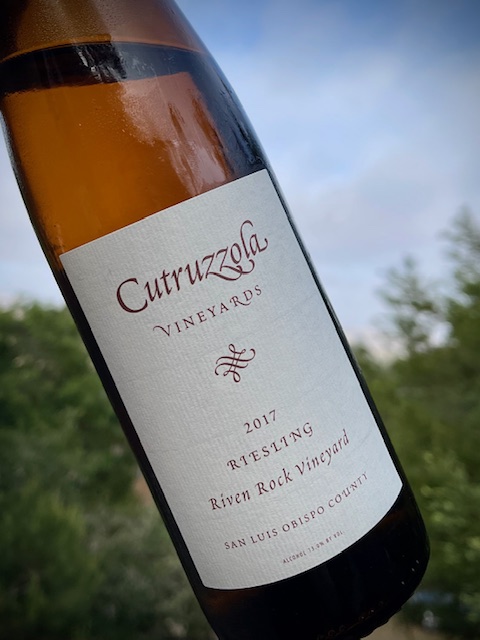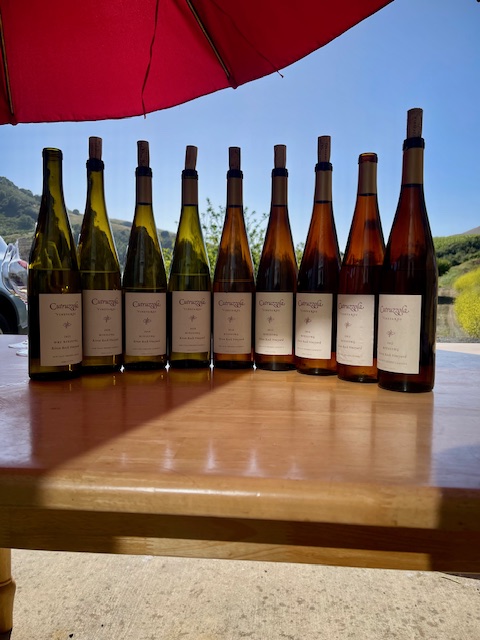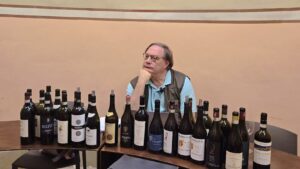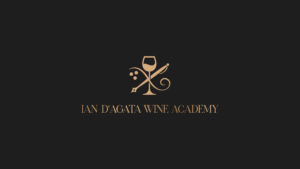Tucked into the rolling hills just outside the small coastal town of Cambria—only about fifteen kilometers from the Pacific Ocean—Cutruzzola Vineyards sits at the northwestern edge of San Luis Obispo County, where the Santa Lucia Mountains drop steeply toward the sea. This cool, maritime-influenced corner of California is better known for its dramatic coastline and cypress forests than for vineyards, but it’s precisely this unique setting that gives rise to one of the state’s most compelling expressions of Riesling wines.

During my recent visit, I had the pleasure of spending time with owners Frank and Lisa Cutruzzola. Frank, a former radiologist, brings to viticulture a rare combination of scientific precision and intellectual curiosity. Though not the winemaker himself, he’s deeply engaged with the vineyard and brings a thoughtful, almost academic approach to farming and wine appreciation.
What struck me most, however, was his boundless enthusiasm for the great wines of the world and his love for deep conversation over food. We shared a long discussion that touched on Burgundy, Tocai Friulano, Schioppettino, Franciacorta, Champagne, Hunter Valley Semillon, Margaret River, and Taurasi—all while enjoying a plate of pici with guanciale and pecorino, followed by patate in tecia (a Friulian-style potato and onion dish) served with pork chop and sausage. Frank is not only a thinker and a taster—he’s someone who understands wine in a global context, with an open mind and an inquisitive palate.
The Site: Coastal Precision
Among Pinot Noir and a new planting of Syrah, Cutruzzola devotes a little less than a hectare to Riesling—Clone 2 on 420A rootstock—on a site characterized by its calcareous soils and strong coastal influence. With foggy mornings and cool afternoons, this western Cambria vineyard sees a long ripening period that protects acidity while promoting complex phenolic development. Harvest typically occurs in mid-September, with ideal numbers: pH in the 3.2–3.4 range and total acidity around 8 g/L.
The soils—rich in fractured shale and limestone—contribute to the wine’s structural depth and sapid profile, while the site’s elevation and exposure help preserve aromatic clarity and vibrancy.
Vinification: Purity with Texture
The Riesling is fermented and aged entirely in stainless steel to emphasize purity, freshness, and varietal definition. It remains on its fine lees for ten months before bottling—a practice that enhances texture without compromising lift. Earlier vintages saw residual sugar around 22 g/L, but starting in 2014, Frank and the team began dialing it back. Since 2015, the style has stabilized around 5–6 g/L, resulting in an off-dry expression with impeccable balance.
In their youth, these wines can exhibit an aroma that might be mistaken for petroleum. However, this is actually a reductive quality—commonly encountered in tightly sealed stainless steel-aged whites—that lifts with air, revealing the wine’s true aromatic profile. The classic petrol note associated with mature Riesling, caused by the compound 1,1,6-trimethyl-1,2-dihydronaphthalene (TDN), only emerges after extended bottle aging, typically around the 10-year mark. When it does, it adds an additional layer of complexity, complementing the wine’s evolving stone fruit, herbal, and citrus-driven character.
Tasting Note: Focused and Saline
Recent bottlings are marked by high-toned aromas of lime zest, ginger root, fennel, and stone fruit, with a mouthwatering, savoury palate that speaks to both maritime influence and careful lees aging. There’s real architecture here: the acidity crackles, the fruit is vivid, and the finish lingers with savory complexity. It’s a wine that rewards slow drinking—and even more so, cellaring.
Riesling is still a rare bird in California, and even rarer when made with this level of precision and intent. Cutruzzola’s version doesn’t chase trends; instead, it delivers clarity, energy, and structure that could easily be mistaken for a European origin in a blind tasting. It is a wine that speaks softly but with confidence, revealing its layers over time rather than all at once.
Cutruzzola Vineyards’ Riesling is one of the most intellectually satisfying and gastronomically versatile white wines I’ve encountered on the Central Coast. It’s a testament not only to the potential of Cambria as a white wine terroir, but also to the thoughtfulness of people like Frank and Lisa, whose love for great wine—and great food—shines through in every bottle.
For those who believe California Riesling has untapped potential, this is the wine that proves the case.

The wines in this report
All wines were tasted at the property.




